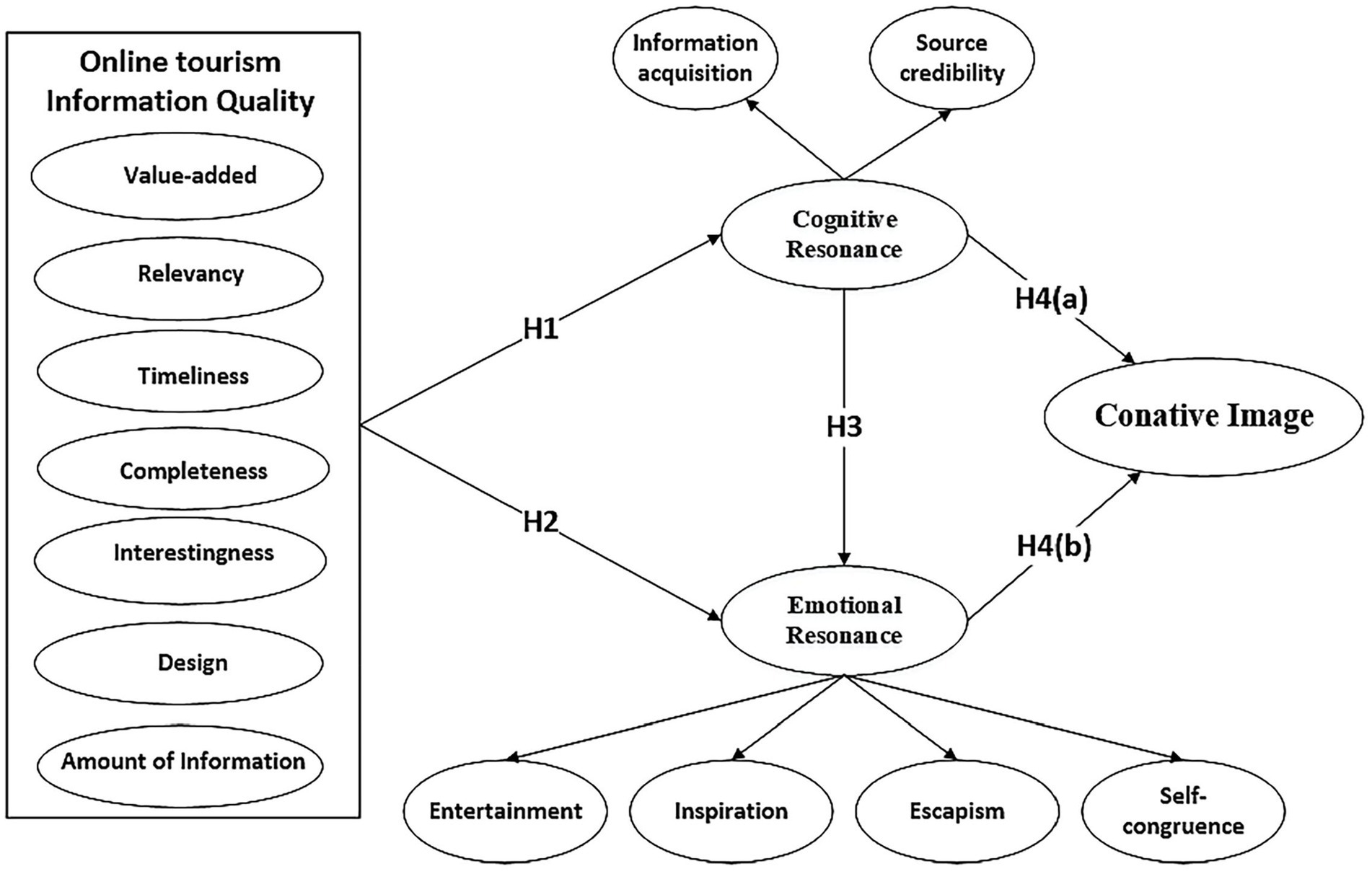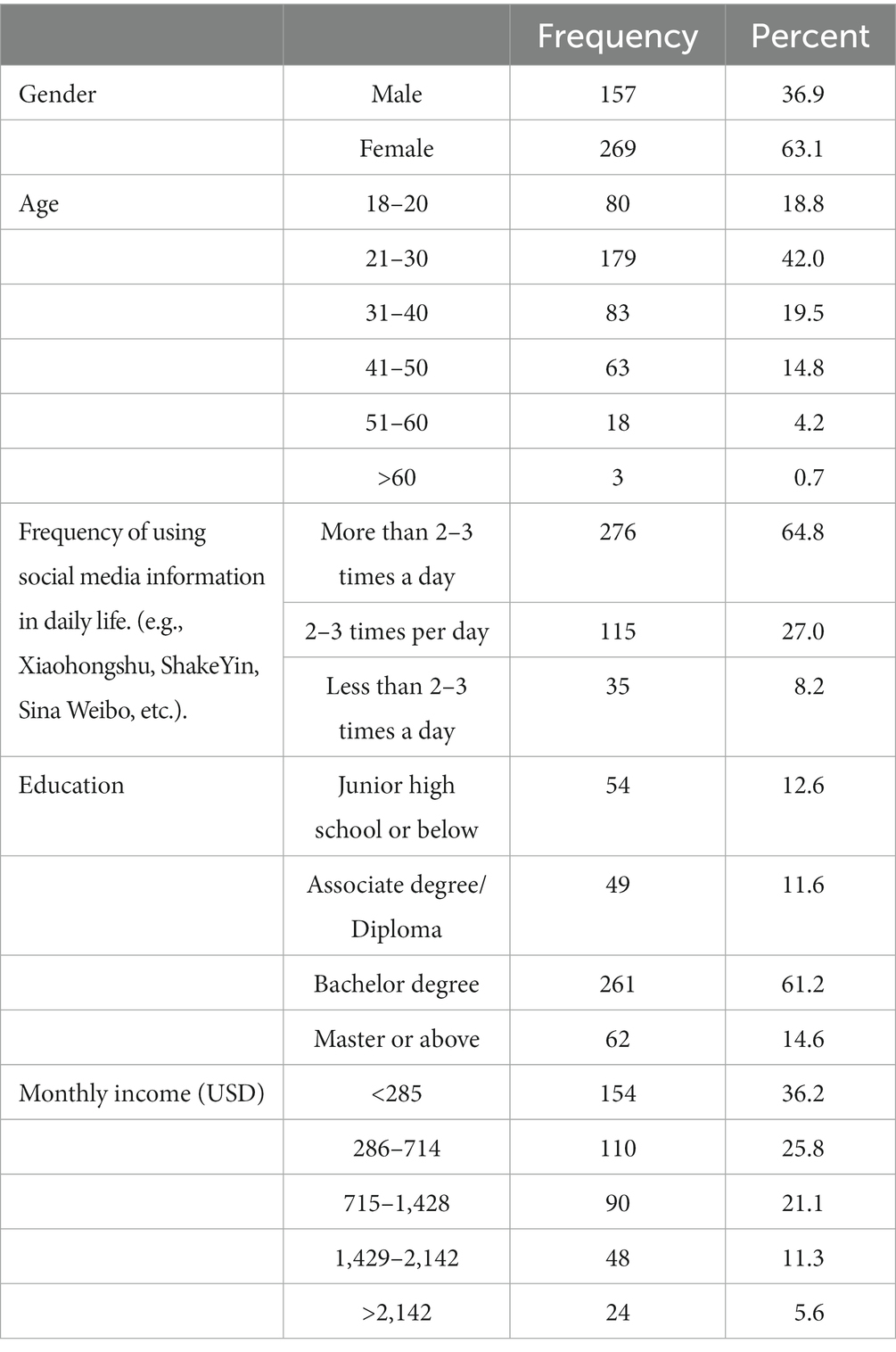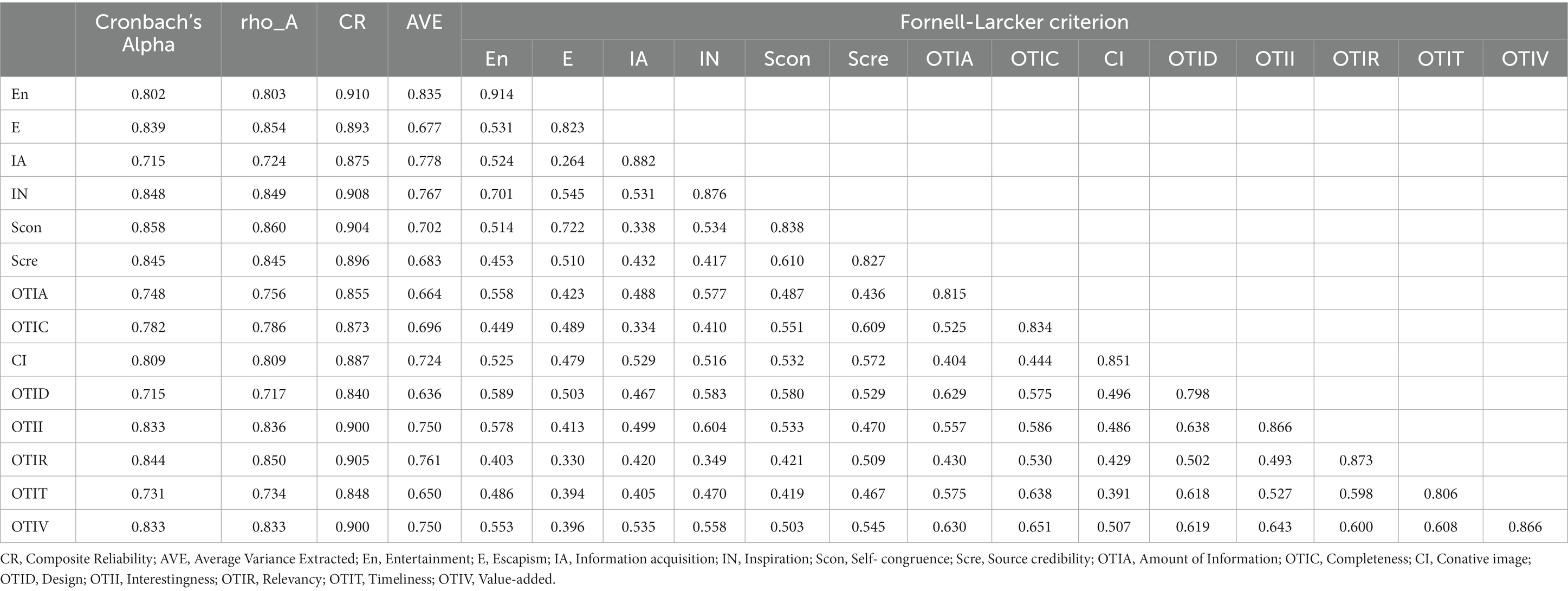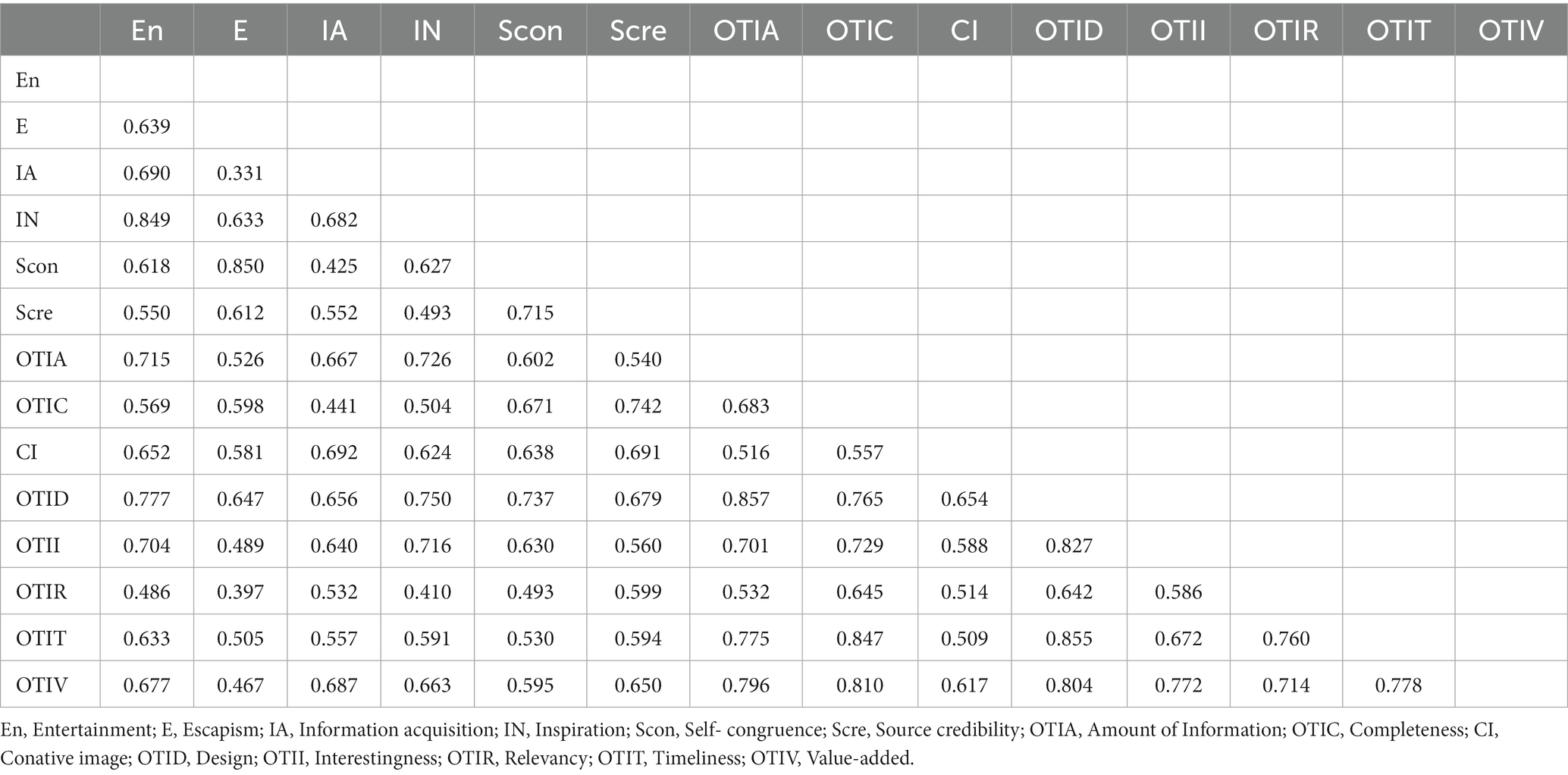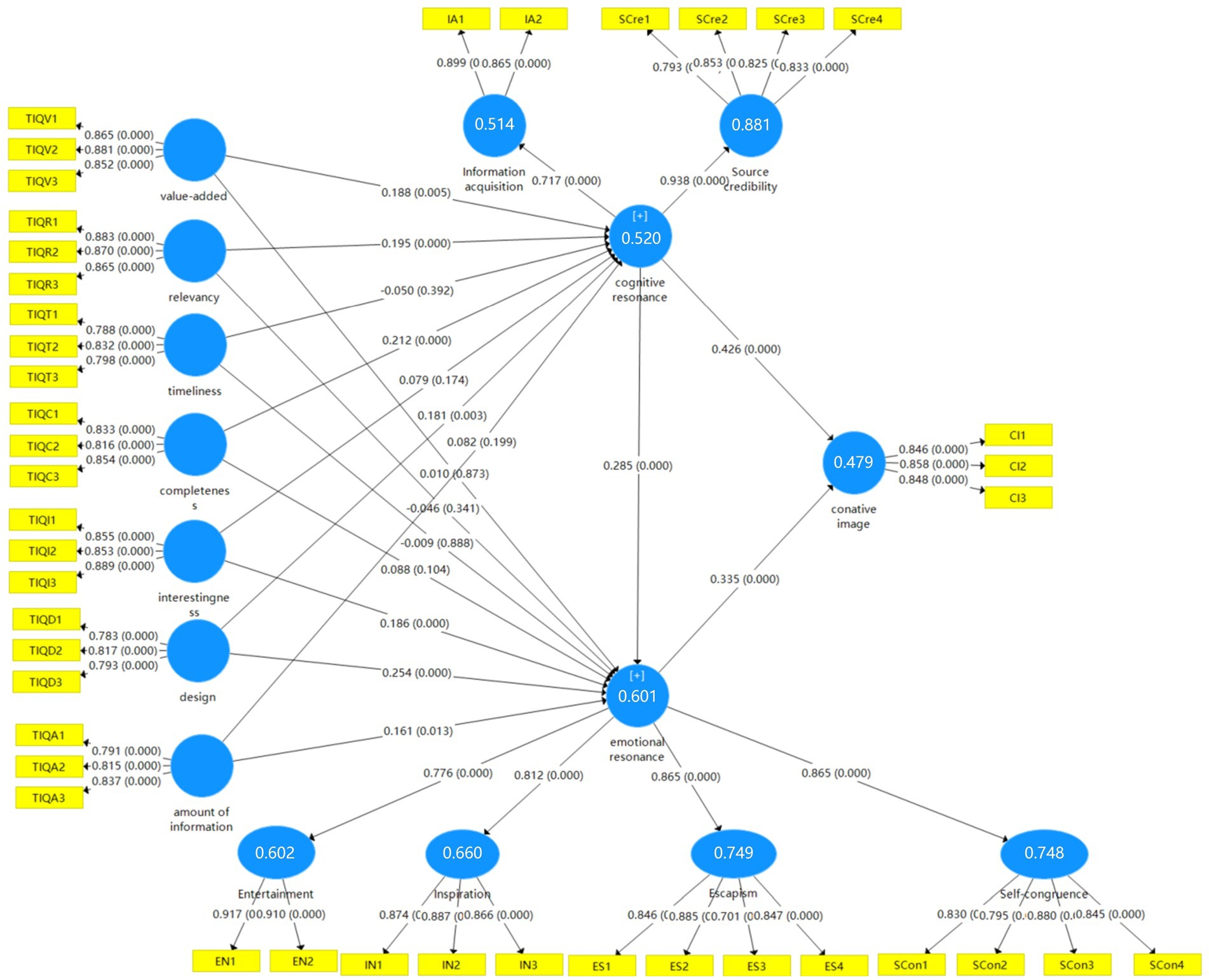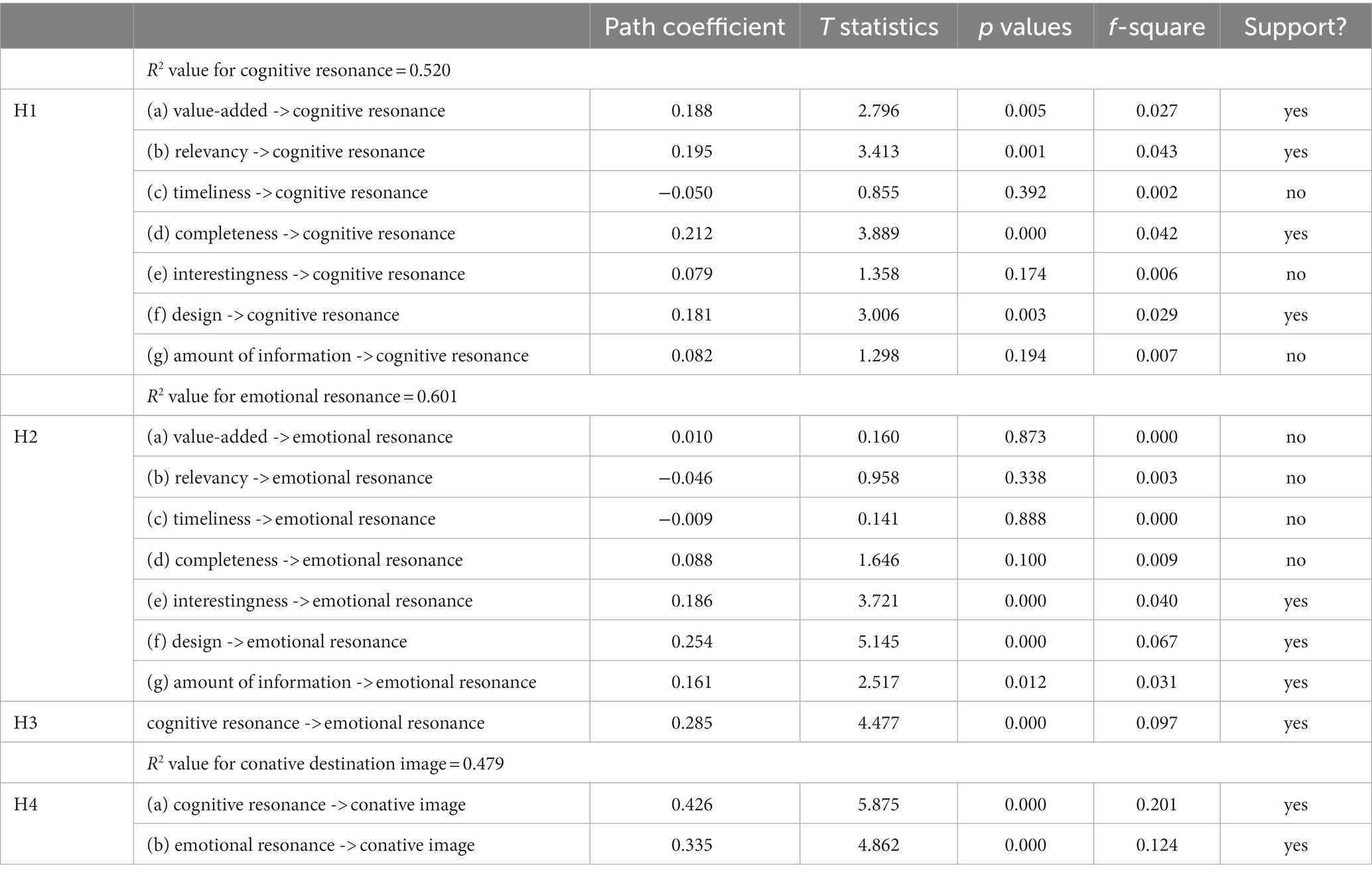- 1Faculty of International Tourism and Management, City University of Macau, Macao, Macao SAR, China
- 2Research Center for Culture and Tourism Law, Hangzhou City University, Hangzhou, Zhejiang, China
With the increasing popularity of mobile applications, people enjoy browsing online tourism information on social media. This information may cause psychological resonance, which in turn stimulates travel intentions. This study examined the relationship between online travel information quality (OTIQ), resonance, and conative destination image. A partial least squares structural equation model was used to analyze the survey data of 426 users who recently used social media to browse online tourism information. The results show that four dimensions of OTIQ (value-added, relevancy, completeness, and design) affect cognitive resonance, and three dimensions of OTIQ (interestingness, design, and amount of information) affect emotional resonance. Both cognitive resonance and emotional resonance directly affect the conative destination image. This study contributes to online tourism marketing research by identifying the factors of OTIQ that rise tourists’ resonance. It also contributes to destination image research by extending the application of resonance theory and examining the role of cognitive resonance and emotional resonance in forming a conative destination image. Understanding how QTIQ builds a destination image can help destinations improve the quality of online tourism information to attract potential tourists. This study also provides recommendations to destination marketers to formulate appropriate marketing strategies in the age of innovative technology.
1. Introduction
Social media as a new marketing tool for tourism destinations, its mechanism of influence of online tourism information on destination image formation has been receiving attention from the tourism industry and academia (Lam et al., 2020). By July 2022, the number of social media users worldwide had surpassed 4.7 billion, and they used social media for more than 2 h a day on average (Kepios, 2022). The valuable information provided by online social media not only makes new marketing of commodities, services, and communication possible but also changes the way people make travel decisions (Khan, 2017). According to a U.S. statistic, 97% of millennials post photos on social media while on vacation. And about 52% of travelers decide to go to a specific destination after seeing photos/videos of friends, family, or peers on social media (Statistics, 2022). Every week, over 1 million travel-related hashtags are searched on Instagram (a worldwide popular social media app; Statistics, 2022). Social media has become their first-choice channel for getting tourism information (Wang et al., 2022). Social media users watch travel pictures, opinions, reviews, comments, and travel experiences shared by others on social media, either automatically pushed by Apps or by their deliberated search (Majeed et al., 2020). Although we know that a series of tourist information generated by users has shaped the image of a destination in people’s minds, which influences people’s travel decision-making (Fan et al., 2020), we do not know what types of information influence people most in choosing a destination. Therefore, a study is needed to understand the various tourism information on social media and its impact on online tourism marketing.
Recent studies indicated that online tourism information quality (OTIQ) is an important indicator in shaping the online tourism market and contributing to the formation of destination image (Kim et al., 2017). Researchers have examined the effects of influential online tourism information on online users’ travel purchases intention (Hateftabar, 2022), visit intentions (Cheng et al., 2020), and word-of-mouth recommendations (Majeed et al., 2020), which are the components of destination conative image. Although previous studies have indicated that online information content is the key factor influencing tourists’ conative behavior (Lam et al., 2020; Majeed et al., 2020), there is a lack of studies to explain the mechanism of how OTIQ influences tourists’ conative behaviors regarding the formation of the conative destination image.
The resonance theory originates from sociological research and emphasizes positive cognitive and emotional consequences (Giorgi, 2017). Researchers applied the resonance theory to explain how customers can match the information with their internal worldview when they are receiving online information (Camilleri and Kozak, 2022). The resonance theory states that adequate information will arouse the audience’s cognitive resonance and emotional resonance, and they can influence customers’ further behavioral intentions (Cheng et al., 2020). A literature search of mainstream databases (EBSCOhost, Scopus, and ScienceDirect) revealed that there were only two empirical tourism studies on resonance. These two studies tested the effect of users’ resonance with travel blogs on word-of-mouth and travel behavioral intentions (Cheng et al., 2020; Mohanty et al., 2022). In this case, it is possible that high-quality online information can rise tourists’ resonance reactions, ultimately influencing tourists’ perceptions of destination conative image. However, no research has been found on the psychological resonance of receiving high-quality tourism information in tourism research.
This study aims to examine the relationship between online tourism information quality (OTIQ), resonance, and conative destination image. Firstly, this study contributes to online tourism marketing research by identifying the factors of OTIQ that rise tourists’ resonance, thereby prompting them to generate a conative destination image. Understanding this mechanism helps destinations improve the quality of online tourism information to attract potential social media users to become destination tourists. Secondly, this study extends the application of resonance theory in destination image research by examining the role of cognitive resonance and emotional resonance in forming a conative destination image. Finally, the results of this study help destination marketers grasp accurate online tourism information and effectively carry out online tourism marketing promotion.
The study is organized as follows. A brief literature review of online tourism information quality, resonance theory, and conative destination image is provided in the next section. Then, the research methods and data analysis are described in Sections “Research hypotheses” and “Research methods”, respectively. In Section “Findings”, conclusions are drawn, the theoretical and practical implications are discussed, and the limitations of this study and recommendations for further research are presented.
2. Literature review
2.1. Conative destination image
Previous studies on the destination image have shown that destination image can affect a destination’s competitiveness in the market (Liang and Lai, 2022), thus how a destination can stand out from a favorable destination image is one of the most explored areas in tourism research. Hunt (1975) defined destination image as an individual’s beliefs, impressions, and perceptions of a specific place. Initially, researchers proposed a two-dimensional tourism destination image model, in which the tourism destination image contains both a cognitive image and an affective image (Gartner, 1994). The cognitive image relates to a person’s knowledge and beliefs about a tourism destination, and the affective image relates to how they feel about the destination (Baloglu and McCleary, 1999). Later on, researchers developed a conative destination image construct, which involves tourists’ behavioral intentions (Ryan and Ninov, 2011). A conative destination image is a collection of future actions, and it contains three test items, i.e., “intention to recommend, positive word of mouth, intention to revisit” (Woosnam et al., 2020). Lojo et al. (2020) stated that to effectively market a destination and form a market position, it is most important to identify the factors that influence the formation of the conative image of the destination. Besides cognitive image and emotional image, previous articles have shown that many factors (e.g., travel experience, positive emotions, etc.) can influence recommendation intention, word-of-mouth, and revisit intention (Hosany et al., 2017; Wang et al., 2023). However, most studies examined the factors for the conative image based on travel experience after visiting a destination. For tourists before visiting a destination, Wang et al. (2020) pointed out that their conative destination image is highly susceptible to user-generated tourism content on social media, however, there is a lack of studies to link how online tourism information affects tourists’ psychological status, and then influences tourists’ conative image.
2.2. Online tourism information quality
At the beginning of the 21st century, tourism information began to appear on the internet and gradually evolved into a channel for tourism organizations to communicate with tourists (Xiang and Gretzel, 2010). The emergence of Web 2.0 makes tourists easy to create and share information with other tourists on social media (Aghaei, 2012). Therefore, social media have become the most influential marketing tool for the public, businesses, and government organizations (Hays et al., 2013), because tourists consider social media to be the most trusted source of information about a destination (Fotis et al., 2012). Tourists can consult travel information on social media to support their travel decisions pre-trip, during a trip, and post-trip (Wang et al., 2022).
As information recipients, tourists obtain online travel information on social media published by information providers (Lu et al., 2016). However, tourists may be confused by the vast amount of online travel information pushed by information providers (Dharmasena and Jayathilaka, 2021), therefore, they have to pay attention to the quality of online travel information. However, previous studies mainly focused on the content of the travel information rather than the quality of travel information until Kim et al. (2017) introduced the concept of the OTIQ. Based on Chaiken’s (1980) heuristic system model, Kim et al. (2017) developed a multi-level OTIQ model for social media that includes content qualities (i.e., value-added, relevancy, timeliness, completeness, and interestingness) and non-content qualities (i.e., web page design and amount of information). Researchers have applied the multidimensional OTIQ scale to examine the impact of online travel information on the formation of the destination image in different scenarios (Rodríguez et al., 2019; Guo and Pesonen, 2022). However, these studies only tested tourists’ behavioral intentions when viewing online information on social media without investigating their psychological changes. There is a lack of studies on how online information affects travelers’ psychological status.
2.3. The role of resonance theory
Resonance is one of the most widespread sociological concepts that was initially used to explain an individual’s understanding of an organizational framework (Snow et al., 1986). Researchers have applied it to describe the fit between information and audience worldviews (McDonnell et al., 2017). There are two main types of resonance, cognitive resonance and emotional resonance. Cognitive resonance is based on the audience’s beliefs and understanding, and emotional resonance is based on the audience’s feelings, passions, and desires (Giorgi, 2017). These two types of resonance lead to positive consequences (Snow et al., 1986; Su et al., 2019). For their antecedents, researchers found that cognitive resonance can be achieved when people can interpret their understanding of information in a way that matches their expectations (Shang et al., 2017), and emotional resonance can be achieved when acquired information arises people’s curiosity and desire (Kang et al., 2020). Emotional resonance usually interpenetrates with cognitive resonance and eventually leads to a strong resonance that lasts for a period of time (McDonnell et al., 2017). Therefore, if tourists find that the travel information on social media meets their expectations and generates desires, they will have cognitive resonance and emotional resonance. However, what types of online travel information (content qualities and non-content qualities) can arise tourists’ cognitive resonance and emotional resonance are still a question that should be investigated.
3. Research hypotheses
In recent years, social media has been recognized as the most important source of acquiring tourism information (Lee et al., 2019). People are not only read travel information on social media but also involve in discussing travel information in the comment area (Camilleri and Kozak, 2022). According to the multi-level OTIQ model for social media (Kim et al., 2017), tourists would receive content qualities and non-content qualities (value-added, relevancy, timeliness, completeness, interestingness, design, and amount of information) of online information when they browse destination travel information on social media. When the information people received is consistent with their expectation and meet their demands, they are likely to have cognitive resonance with them (McDonnell et al., 2017). On the other hand, when the information people received is interesting and amazing, this information is more likely to facilitate conversations and emotional exchanges with the audience (Mangold and Faulds, 2009), therefore, they are more likely to respond emotionally to the information content (Shang et al., 2017). In general, the information posted online includes attractions and accommodations in a destination (Wang et al., 2022), which helps tourists plan their trips. Furthermore, online information about a destination also includes tourism activities and entertainment (Wong et al., 2020), which stimulates tourists’ interests. Then, if tourists find the online travel information sufficient, useful, and relevant, they will have a cognitive resonance with the online travel information; if tourists find the online travel information interesting and amazing, they will have an emotional resonance with the online travel information. Therefore, the following two sets of hypotheses are proposed.
H1: When tourists browse travel information on social media, its value-added (a), relevancy (b), timeliness (c), completeness (d), interestingness (e), design (f), amount of information (g), positively influences their cognitive resonance.
H2: When tourists browse travel information on social media, its value-added (a), relevancy (b), timeliness (c), completeness (d), interestingness (e), design (f), amount of information (g), positively influences their emotional resonance.
Cognitive resonance and emotional resonance are not mutually independent, these two resonances have a complex permeating process, as it is not only the mundane that people focus on but the emotional touch that the event brings (Giorgi, 2017). Since people searching for information is driven by emotions (McDonnell et al., 2017), tourists’ emotions will be affected by their cognitive resonance from the context of online travel information they obtained from social media. If tourists cannot get cognitive resonance from online travel information, they will not have a feeling of emotional resonance. It means that tourists find online travel information interesting once they find online travel information useful. Therefore, cognitive resonance is a necessary condition for tourists to have emotional resonance from online travel information.
H3: Tourists’ cognitive resonance positively influences their emotional resonance.
Giorgi (2017) suggested that resonance is an antecedent of the audiences’ intentional output. Previous studies have shown a positive relationship between engagement with travel information on social media and tourists’ behavioral intention (Tran, 2020). Mohanty et al. (2022) found that cognitive resonance and emotional resonance can facilitate social media engagement behaviors. Therefore, the cognitive resonance and emotional resonance obtained by engaged tourists from online travel information may contribute to the formation of the destination image. Cheng et al. (2020) stated that when browsing travel information on social media, tourists are emotionally inspired by the received information, which in turn forms the destination image or forms a visit intention. Wu and Lai (2022) pointed out that tourists are influenced by media information and are keen to go to destinations which impress them and conform to their self-congruity. This means that tourists’ cognitive resonance and emotional resonance to online travel information may directly influence their perception of the conative image of a destination. Therefore, the following hypotheses are proposed.
H4: Tourists’ (a) cognitive resonance and (b) emotional resonance positively influence their conative image of a destination.
This study aims to examine the relationship between OTIQ, cognitive resonance, emotional resonance, and conative image. The hypothetical model is shown in Figure 1.
4. Research methods
4.1. Measurement
The measurable items of seven factors (amount of information, completeness, design, interestingness, relevancy, timeliness, and value-added) of OTIQ used in this study are inspired by Kim et al. (2017). The measurable items of cognitive resonance and affective resonance are borrowed from Cheng et al. (2020). The measurable items of the conative image are borrowed from Afshardoost and Eshaghi (2020). All the measurement scales have been well-validated in previous studies. To suit the research setting, an expert meeting was conducted to slightly adjust the original measures according to the content of this case. The panel of experts includes two scholars in tourism, a social media company executive, a member of the tourism board, and three tourists who have used social media for planning travel. Experts recommended some modifications such as removing two items referring to video quality and no specific location in measuring conative image.
4.2. Questionnaire design and data collection
This study divided the questionnaire into three sections. The first section consisted of screening questions to ensure that respondents met the criteria for the study. Respondents were screened based on three criteria: (i) being at least 18 years old; (ii) having used social media in daily life; and (iii) having browsed tourism destination information on social media within a week. The second part consisted of seven dimensions of OTIQ, cognitive resonance and emotional resonance, and conative destination image. Respondents were asked to answer the questionnaire based on their last experience browsing online travel information. The questionnaire was measured using a 7-point Likert scale (where “1” = strongly disagree, “7” = strongly agree). The third section was about the respondents’ background information. The English questionnaire was translated into Chinese, and the Chinese questionnaire was back-translated into English by two English-Chinese translators to eliminate translation bias. Expert consultation with five tourism scholars was conducted to validate the content of the questionnaire. A pilot test was conducted with 30 social media users to further ensure the accuracy and readability of the questionnaire. Some adjustments were made to the wording of some items, such as adding explanations for specific social media platforms.
An online survey was conducted from the 1st of September to the 31st of October 2022. The online survey is a non-probability sampling method widely used in tourism research (Cho et al., 2020). Using an online survey in this study can reach more potential participants who have experience in browsing online travel experiences. 480 samples were collected. The 54 questionnaires scored the same scores on most of the questions, so only 426 samples were valid for data analysis. The effective rate of the questionnaire was 88.75%.
5. Findings
The partial least squares structural equation modeling (PLS-SEM) was used to evaluate the research model. Compared with CB-SEM, PLS-SEM has fewer restrictions on the normal distribution of the data (Hair et al., 2017). This study used SmartPLS (v.3.3.9) for data analysis (Ringle et al., 2015). This sample size was satisfied by a power analysis based on the part of the model with the largest number of predictors (Hair et al., 2021).
5.1. Sample overview
Table 1 shows the characteristics of 426 valid respondents. Among the participants, 63.1% were females. The 18–20, 21–30, and 31–40 age groups accounted for 18.8, 42.0, and 19.5%, respectively. 61.2% of participants had a bachelor’s degree. 91.8% of participants used social media 2–3 times or more a day.
5.2. Reliability and validity
Table 2 shows the means, standard deviations (SD), and factor loadings for the 43 measurable items. All factor loadings were above 0.7 and ranged from 0.701–0.917. As shown in Table 3, the Cronbach’s alpha coefficients for each construct exceeded 0.7, the values of Composite Reliability and rho_A for each construct also exceeded 0.7, and the average variance extracted (AVE) scores were greater than 0.50, therefore, substantial reliability and convergent validity were achieved (Hair et al., 2019).
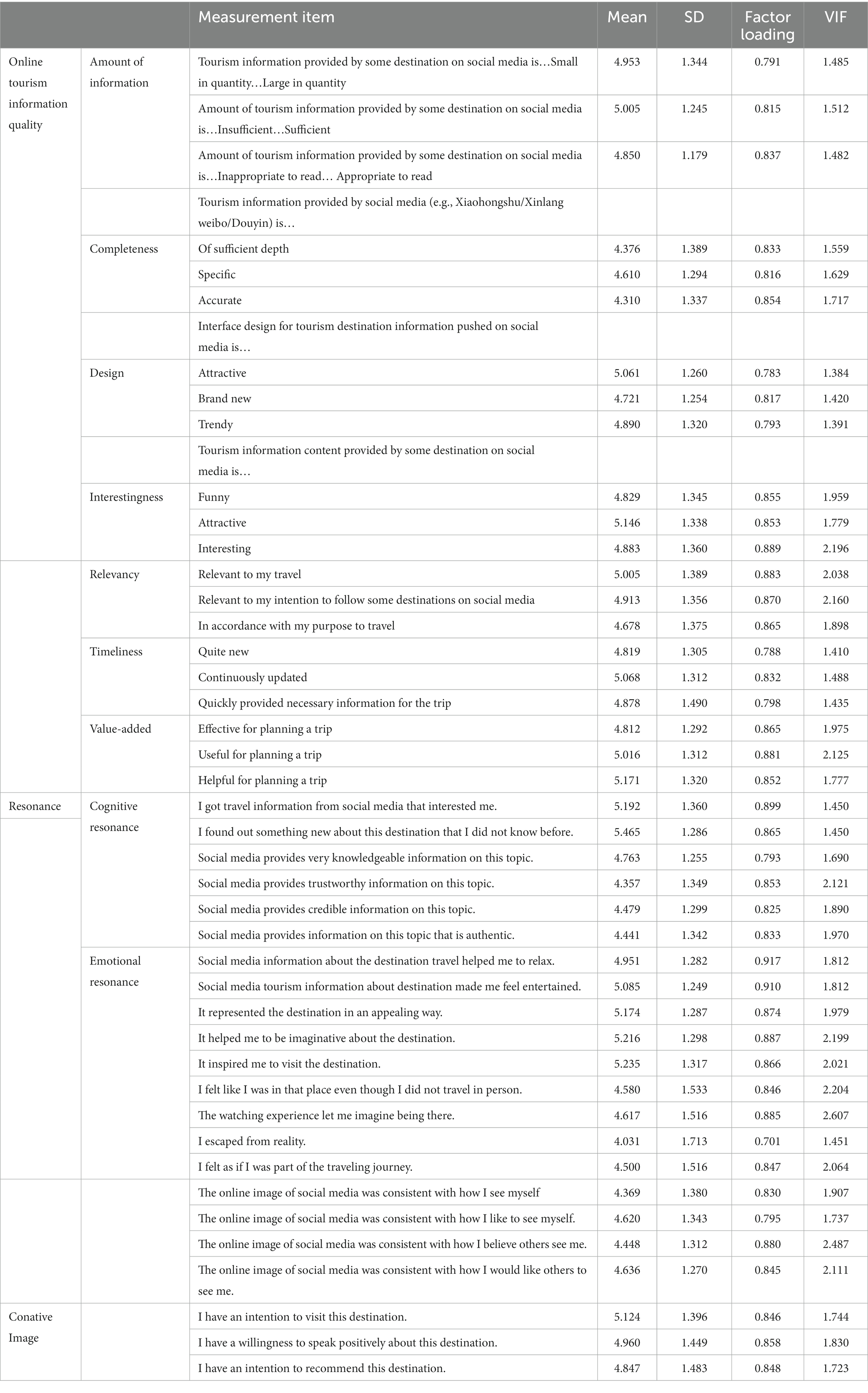
Table 2. Mean, standard deviation (SD), factor loading, and variance inflation factor (VIF) of 43 measurable items.
The correlation between constructs was less than the square root of the AVE score (numbers on the diagonal) and all values of the heterotrait-monotrait (HTMT) ratio were below the indicator 0.9 (Henseler et al., 2015). Table 4 shows the HTMT ratios. Because of high HTMT ratios for the two pairs of ‘Design’ and ‘Amount of information’ (0.857), ‘Timeliness’ and ‘Design’ (0.855), a bootstrapping method was used to assess the inference of HTMT. The values of the confidence interval (97.5%) for both pairs are less than 1, thus, it did not violate the hypothesis of discriminant validity, and the discriminant validity was confirmed (Hair et al., 2021).
This study used Harman’s single-factor test to clarify the absence of common method variance. The results indicated that the first factor explained 39.079% of the variance; as such, the issue of common method variance did not exist in this study (Podsakoff et al., 2003). In addition, the values of all variance inflation factors (VIF) were below 3 (as shown in Table 2), indicating that there was no collinearity problem in this study (Hair et al., 2019).
5.3. Results of partial least squares analysis
This study used a bootstrapping technique of 5,000 re-samples to examine the significance of the statistical hypothesis model (Hair et al., 2017). The results of PLS-SEM are shown in Figure 2; Table 5. The R-squared values of the three endogenous latent variables (cognitive resonance, emotional resonance, and conative image) were 0.520, 0.601, and 0.479, respectively. Four dimensions of online tourism information quality (value-added, relevancy, completeness, design) significantly influence cognitive resonance (βvalue-added = 0.188, value of p = 0.005; βrelevancy = 0.195, value of p = 0.043; βcompleteness = 0.212, value of p < .001; βdesign = 0.181, value of p = 0.003), supporting hypotheses H1 (a), H1 (b), H1 (d), H1 (f). Three dimensions of online tourism information quality (interestingness, design, amount of information) significantly influence emotional resonance (βinterestingness = 0.186, value of p < 0.001; βdesign = 0.254, value of p < 0.001; βamount of information = 0.161, value of p = 0.012), supporting hypotheses H2 (e), H2 (f), H2 (g). Cognitive resonance significantly influences emotional resonance (β = 0.285, value of p < 0.001) and conative image (β = 0.426, value of p < 0.001); emotional resonance significantly influences conative image (β = 0.335, value of p < 0.001). Thus, the hypotheses of H3 and H4 were supported. To assess whether the omitted constructs have a substantial effect on endogenous constructs, effect size f2 values are to be calculated (Hair et al., 2017). The values of f2 for the above significant paths ranged from 0.027 to 0.201, all higher than Cohen’s (2013) criteria effect of size 0.02.
6. Discussion
6.1. Conclusion
Online travel information quality has a significant effect on cognitive resonance in four dimensions (value-added, relevancy, completeness, and design), and among the four dimensions, completeness has the greatest impact, relevancy ranks second. Three dimensions (interestingness, design, and amount of information) of OTIQ have a significant effect on emotional resonance, and among the three dimensions, design has the greatest impact. This means that complete and relevant information is what audiences are searching for, and design (interface layout and attractive headings) can trigger their emotions. This study also found that cognitive resonance and emotional resonance positively influence conative destination image. These results are consistent with Mohanty et al.’s (2022) study that cognitive resonance and emotional resonance stimulated by the information on Travel Vlogs have an effect on travel intention.
6.2. Theoretical implications
Although researchers have classified OTIQ into content cues and non-content cues (Kim et al., 2017; Rodríguez et al., 2019), they did not distinguish how content cues and non-content cues affect audiences’ psychological status. This study indicates that content cues (e.g., relevancy, completeness) strongly stimulate tourists’ cognitive resonance, and non-content cues (e.g., design) strongly stimulate tourists’ emotional resonance. Tourists search for travel information on social media and have a feeling of cognitive resonance once they find the content is relevant and useful for planning the trips, and they have an emotional response once they have an impression of the design of the social media. This study contributes to online tourism marketing research by explaining how online travel information influences tourists’ psychological resonance.
Previous studies have applied the concept of resonance in destination image tourism research (e.g., Cheng et al., 2020), but no studies have evaluated the relationship between cognitive resonance and emotional resonance and no study has compared which resonance has a stronger effect on the formation of the destination image. This study provides evidence to support that cognitive resonance is more important than emotional resonance in forming a conative image of a destination. Cognitive resonance not only directly affects the formation of a conative image but also indirectly affects the formation of a conative image through emotional resonance. This implies that after customers receive online tourism information, they may first filter out information that matches their cognition, thereby affecting emotional resonance. In addition, by applying the concept of resonance, this study provides a complete picture of how OTIQ can create the conative image of a destination. This study contributes to destination image research by extending the application of resonance theory and examining the role of cognitive resonance and emotional resonance in forming a conative destination image.
6.3. Practical implications
This study provides marketers with important insights into online tourism marketing. DMOs should carefully design the information posted on social media to effectively market the destination. The information provided should be value-added, relevancy, and completeness. For example, cooperate with influential KOLs to publish the cultural customs of tourist destinations, Instagram-worthy locations, niche attractions, trending stores, travel itineraries, and other information in a thematic manner on social media. In addition, the interface design is also important. For example, a well-designed virtual appearance interface (subcultural beauty, color scheme, layout of images and video modules) can make a destination stand out from the crowd of online information (Jamshidi et al., 2021). These designs can inspire not only cognitive resonance but also direct emotional resonance.
Social media are one of the strongest marketing mediums in the world, so the results of this study are not only applicable to destination marketing but also applicable to other online tourism marketing areas. For example, hotels can push a large number of esthetically pleasing products and brand information related to target customers on social media to attract customers’ attention, while paying attention to customers’ reactions to each product information in order to make further online marketing. Travel agents should use precision marketing to post complete and valuable travel information on social media, design different packages for multiple users, and use attractive interfaces to appeal to customers’ emotional resonance. High-quality online information helps to gain customers’ recognition and earn a corporate reputation.
6.4. Limitations and future research
The targets of this study were the tourists before visiting a destination. Further research can compare the differences in the paths of two groups of tourists who have and have not visited the destination before. The data were collected in China. Further research is recommended to collect data in different countries to compare any differences in forming resonance and the conative image of a destination. This research model only consists of OTIQ, resonance, and conative image, researchers can extend this research model with other constructs to understand the impact of QTIQ and resonance on destination image in a comprehensive way.
Data availability statement
The original contributions presented in the study are included in the article/supplementary material, further inquiries can be directed to the corresponding author.
Ethics statement
Ethical review and approval was not required for the study on human participants in accordance with the local legislation and institutional requirements. Written informed consent from the participants to participate in this study was not required in accordance with the national legislation and the institutional requirements.
Author contributions
XuW: idea inception, data collection, data analysis, and writing–original draft. XiW: idea inception and refine, writing–review and editing, evolution research goals, and aims. IL: experiment design, data curation, writing–review and editing, evolution research goals, and aims. All authors contributed to the article and approved the submitted version.
Acknowledgments
The authors appreciate the respondents for their participation in this survey.
Conflict of interest
The authors declare that the research was conducted in the absence of any commercial or financial relationships that could be construed as a potential conflict of interest.
Publisher’s note
All claims expressed in this article are solely those of the authors and do not necessarily represent those of their affiliated organizations, or those of the publisher, the editors and the reviewers. Any product that may be evaluated in this article, or claim that may be made by its manufacturer, is not guaranteed or endorsed by the publisher.
References
Afshardoost, M., and Eshaghi, M. S. (2020). Destination image and tourist behavioural intentions: a meta-analysis. Tour. Manag. 81:104154. doi: 10.1016/j.tourman.2020.104154
Aghaei, S. (2012). Evolution of the world wide web: from web 1.0 to web 4.0. I. J. Wes. T. 3, 1–10. doi: 10.5121/ijwest.2012.3101
Baloglu, S., and McCleary, K. W. (1999). A model of destination image formation. Ann. Touris. Res. 26, 868–897. doi: 10.1016/s0160-7383(99)00030-4
Camilleri, M. A., and Kozak, M. (2022). Interactive engagement through travel and tourism social media groups: a social facilitation theory perspective. Technol. Soc. 71:102098. doi: 10.1016/j.techsoc.2022.102098
Chaiken, S. (1980). Heuristic versus systematic information processing and the use of source versus message cues in persuasion. J. Pers. Soc. Psychol. 39, 752–766. doi: 10.1037/0022-3514.39.5.752
Cheng, Y., Wei, W., and Zhang, L. (2020). Seeing destinations through vlogs: implications for leveraging customer engagement behavior to increase travel intention. Int. J. Contemp. Hosp. Manag. 32, 3227–3248. doi: 10.1108/ijchm-04-2020-0319
Cho, H., Tan, K. M., and Chiu, W. (2020). Will I be back? Evoking nostalgia through college students’ memorable exchange programme experiences. Tour. Rev. 76, 392–410. doi: 10.1108/tr-06-2019-0270
Dharmasena, T., and Jayathilaka, R. (2021). The nexus between information and consumer confusion: information provider vs information recipient. Tour. Rev. 76, 594–613. doi: 10.1108/tr-06-2019-0252
Fan, D. X. F., Hsu, C. H. C., and Lin, B. (2020). Tourists’ experiential value co-creation through online social contacts: customer-dominant logic perspective. J. Bus. Res. 108, 163–173. doi: 10.1016/j.jbusres.2019.11.008
Fotis, J., Buhalis, D., and Rossides, N. (2012). “Social media use and impact during the holiday travel planning process,” in Information and Communication Technologies in Tourism eds. M. Fuchs, F. Ricci, and L. Cantoni (Vienna, Austria: Springer-Verlag), 13–24.
Gartner, W. C. (1994). Image formation process. J. Travel Tour. Mark. 2, 191–216. doi: 10.1300/J073v02n02_12
Giorgi, S. (2017). The mind and heart of resonance: the role of cognition and emotions in frame effectiveness. J. Manage. Stud. 54, 711–738. doi: 10.1111/joms.12278
Guo, X., and Pesonen, J. A. (2022). The role of online travel reviews in evolving tourists’ perceived destination image. Scand. J. Hosp. Tour. 22, 372–392. doi: 10.1080/15022250.2022.2112414
Hair, J., Hollingsworth, C. L., Randolph, A. B., and Chong, A. Y. L. (2017). An updated and expanded assessment of PLS-SEM in information systems research. Ind. Manage. Data Syst. 117, 442–458. doi: 10.1108/imds-04-2016-0130
Hair, J. F. Jr, Hult, G. T. M., Ringle, C. M., and Sarstedt, M. (2021). A Primer on Partial Least Squares Structural Equation Modeling (PLS-SEM). Thousand Oaks, CA: Sage publications.
Hair, J. F., Risher, J. J., Sarstedt, M., and Ringle, C. M. (2019). When to use and how to report the results of PLS-SEM. Eur. Bus. Rev. 31, 2–24. doi: 10.1108/ebr-11-2018-0203
Hateftabar, F. (2022). Analyzing the adoption of online tourism purchases: effects of perceived tourism value and personal innovativeness. Curr. Issue Tour. 1, 1–17. doi: 10.1080/13683500.2022.2071682
Hays, S., Page, S. J., and Buhalis, D. (2013). Social media as a destination marketing tool: its use by national tourism organisations. Curr. Issues Tour. 16, 211–239. doi: 10.1080/13683500.2012.662215
Henseler, J., Ringle, C. M., and Sarstedt, M. (2015). A new criterion for assessing discriminant validity in variance-based structural equation modeling. J. Acad. Mark. Sci. 43, 115–135. doi: 10.1007/s11747-014-0403-8
Hosany, S., Prayag, G., Van Der Veen, R., Huang, S., and Deesilatham, S. (2017). Mediating effects of place attachment and satisfaction on the relationship between tourists’ emotions and intention to recommend. J. Travel Res. 56, 1079–1093. doi: 10.1177/0047287516678088
Hunt, J. D. (1975). Image as a factor in tourism development. J. Travel Res. 13, 1–7. doi: 10.1177/004728757501300301
Jamshidi, D., Rousta, A., and Shafei, R. (2021). Social media destination information features and destination loyalty: does perceived coolness and memorable tourism experiences matter? Curr. Issues Tour. 26, 407–428. doi: 10.1080/13683500.2021.2019204
Kang, S., Kim, W. G., and Park, D. (2020). Understanding tourist information search behaviour: the power and insight of social network analysis. Curr. Issues Tour. 24, 403–423. doi: 10.1080/13683500.2020.1771290
Kepios. (2022). Global social media statistics. Available at: https://datareportal.com/social-media-users (Accessed October 15, 2022)
Khan, M. L. (2017). Social media engagement: what motivates user participation and consumption on YouTube? Comput. Hum. Behav. 66, 236–247. doi: 10.1016/j.chb.2016.09.024
Kim, S.-E., Lee, K. Y., Shin, S. I., and Yang, S.-B. (2017). Effects of tourism information quality in social media on destination image formation: the case of Sina Weibo. Inf. Manag. 54, 687–702. doi: 10.1016/j.im.2017.02.009
Lam, J. M. S., Ismail, H., and Lee, S. (2020). From desktop to destination: user-generated content platforms, co-created online experiences, destination image and satisfaction. J. Destin. Mark. Manag. 18:100490. doi: 10.1016/j.jdmm.2020.100490
Lee, H., Chung, N., and Nam, Y. (2019). Do online information sources really make tourists visit more diverse places?: based on the social networking analysis. Inf. Process. Manage. 56, 1376–1390. doi: 10.1016/j.ipm.2018.01.005
Liang, S.-H., and Lai, I. K. W. (2022). Tea tourism: designation of origin brand image, destination image, and visit intention. J. Vacat. Mark. ahead-of-print :135676672210999. doi: 10.1177/13567667221099952
Lojo, A., Li, M., and Xu, H. (2020). Online tourism destination image: components, information sources, and incongruence. J. Travel Tour. Mark. 37, 495–509. doi: 10.1080/10548408.2020.1785370
Lu, A. C. C., Gursoy, D., and Lu, C. Y. R. (2016). Antecedents and outcomes of consumers’ confusion in the online tourism domain. Ann. Touris. Res. 57, 76–93. doi: 10.1016/j.annals.2015.11.020
Majeed, S., Zhou, Z., Lu, C., and Ramkissoon, H. (2020). Online tourism information and tourist behavior: a structural equation modeling analysis based on a self-administered survey. Front. Psychol. 11:599. doi: 10.3389/fpsyg.2020.00599
Mangold, W. G., and Faulds, D. J. (2009). Social media: the new hybrid element of the promotion mix. Bus. Horiz. 52, 357–365. doi: 10.1016/j.bushor.2009.03.002
McDonnell, T. E., Bail, C. A., and Tavory, I. (2017). A theory of resonance. Sociol. Theor. 35, 1–14. doi: 10.1177/0735275117692837
Mohanty, S., Pradhan, B. B., and Sahoo, D. (2022). A study to investigate Consumer’s resonance experience effect and engagement behaviour on travel vlogs. NMIMS Manag. Rev. 30, 35–57. doi: 10.53908/nmmr.300203
Podsakoff, P. M., MacKenzie, S. B., Lee, J. Y., and Podsakoff, N. P. (2003). Common method biases in behavioral research: a critical review of the literature and recommended remedies. J. Appl. Psychol. 88, 879–903. doi: 10.1037/0021-9010.88.5.879
Ringle, C. M., Wende, S., and Becker, J. M. (2015). SmartPLS 3. SmartPLS GmbH. Bönningstedt, Germany.
Rodríguez, M., Nassanbekova, S., Pérez, L. M., and Uruzbayeva, N. (2019). The impact of information quality in DMOs’ Facebook pages on the formation of destination image in the silk road: the case of Almaty. Kazakhstan. Curr. Issues Tour. 23, 1587–1592. doi: 10.1080/13683500.2019.1646225
Ryan, C., and Ninov, I. (2011). Dimensions of destination images—the relationship between specific sites and overall perceptions of place: the example of Dubai Creek and “greater Dubai”. J. Travel Tour. Mark. 28, 751–764. doi: 10.1080/10548408.2011.611743
Shang, S. S. C., Wu, Y.-L., and Sie, Y.-J. (2017). Generating consumer resonance for purchase intention on social network sites. Comput. Hum. Behav. 69, 18–28. doi: 10.1016/j.chb.2016.12.014
Snow, D. A., Rochford, E. B., Worden, S. K., and Benford, R. D. (1986). Frame alignment processes, micromobilization, and movement participation. Am. Sociol. Rev. 51:464. doi: 10.2307/2095581
Statistics. (2022). 35+ stats on how social media affects travel [2022]. Available at: https://passport-photo.online/blog/social-media-vs-travel/ (Accessed October 15, 2022)
Su, N., Mariadoss, B. J., and Reynolds, D. (2019). Emotional and cognitive involvement of consumers with hotel brands on social networking sites. J. Hosp. Tour. Insights. 2, 377–390. doi: 10.1108/jhti-10-2018-0064
Tran, L. T. T. (2020). Online reviews and purchase intention: a cosmopolitanism perspective. Tour. Manag. Perspect. 35:100722. doi: 10.1016/j.tmp.2020.100722
Wang, Z., Huang, W.-J., and Liu-Lastres, B. (2022). Impact of user-generated travel posts on travel decisions: a comparative study on Weibo and Xiaohongshu. Ann. Touris. Res. 3:100064. doi: 10.1016/j.annale.2022.100064
Wang, X., Lai, I. K. W., and Wang, K. (2023). Do young women travellers really consider the risk of sexual harassment during night travel? Evening travel vs midnight travel. Tour. Rev. 78, 58–71. doi: 10.1108/TR-12-2021-0563
Wang, J., Li, Y., Wu, B., and Wang, Y. (2020). Tourism destination image based on tourism user generated content on internet. Tour. Rev. 76, 125–137. doi: 10.1108/TR-04-2019-0132
Wong, J. W. C., Lai, I. K. W., and Tao, Z. (2020). Sharing memorable tourism experiences on mobile social media and how it influences further travel decisions. Curr. Issues Tour. 23, 1773–1787. doi: 10.1080/13683500.2019.1649372
Woosnam, K. M., Stylidis, D., and Ivkov, M. (2020). Explaining conative destination image through cognitive and affective destination image and emotional solidarity with residents. J. Sustain. Tour. 28, 917–935. doi: 10.1080/09669582.2019.1708920
Wu, X., and Lai, I. K. W. (2022). How destination personality dimensions influence film tourists’ destination loyalty: an application of self-congruity theory. Curr. Issue Tour. 1-16, 1–16. doi: 10.1080/13683500.2022.2140401
Keywords: online tourism information quality, cognitive resonance, emotional resonance, conative destination image, destination marketing strategies
Citation: Wang X, Wang X and Lai IKW (2023) The effects of online tourism information quality on conative destination image: The mediating role of resonance. Front. Psychol. 14:1140519. doi: 10.3389/fpsyg.2023.1140519
Edited by:
Zhiping Hou, Guilin University of Technology, ChinaReviewed by:
Tamara Gajić, Serbian Academy of Sciences and Arts, SerbiaKrit Phanpanya, Maejo University, Thailand
Copyright © 2023 Wang, Wang and Lai. This is an open-access article distributed under the terms of the Creative Commons Attribution License (CC BY). The use, distribution or reproduction in other forums is permitted, provided the original author(s) and the copyright owner(s) are credited and that the original publication in this journal is cited, in accordance with accepted academic practice. No use, distribution or reproduction is permitted which does not comply with these terms.
*Correspondence: Xin Wang, eHdhbmdAY2l0eXUubW8=
 Xueyi Wang
Xueyi Wang Xin Wang
Xin Wang Ivan Ka Wai Lai
Ivan Ka Wai Lai